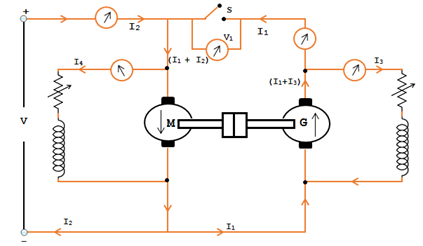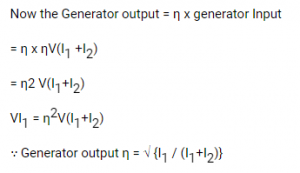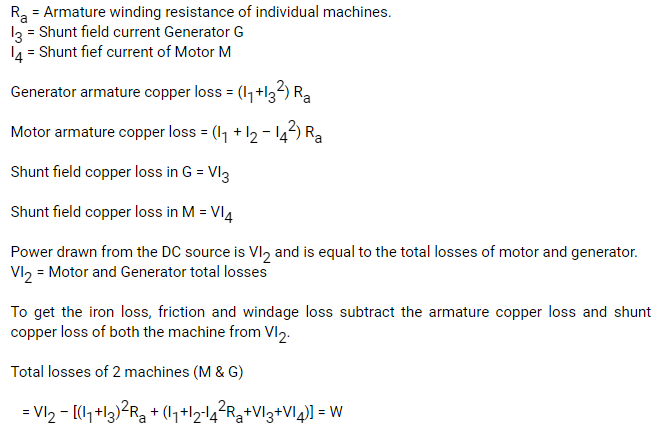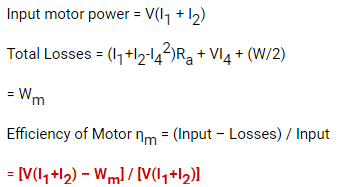Hopkinson’s test or regenerative test is a full load test and it requires two identical machines which are coupled to each other.In this test two identical d.c. machines mechanically coupled to each other and simultaneously tested.One is operated as generator another one as the motor, hence we can find the efficiency of two dc machines simultaneously.So output power of dc machines is going to be wasted.The mechanical output of motor given to generator through the shaft to shaft mechanical coupling.And generator’s electrical power supplied to run the motor, where losses will be supplied by the external power source.
If there are no losses in the motor-generator set, the electrical power from the generator and mechanical output from the motor are enough to run motor, generator respectively.So no need for any external power supply to the motor.But due to losses, the generator output is not sufficient to drive the motor. Thus motor takes current from the supply to account for losses.
Observe circuit diagram of Hopkinson’s test. The two shunt dc machines are connected in parallel. In that two machines, one is started as a motor another one operated as the generator.Here the only rotor connections are mentioned, stator connections are not shown for simplicity.
Connection Diagram of Hopkinson’s Test
First switch S is kept open. The other machine which is coupled to first will act as the load on first which is acting as the motor. Thus the second machine will act as a generator.With the help of field rheostat speed of the motor is adjusted to the normal value.Note down the observed voltmeter readings.With the help of generator field rheostat voltage of the generator is adjusted up to voltmeter reading is zero.This is to make sure generator voltage is having same magnitude and polarity of that of the supply voltage.By making this we can prevent heavy circulating current flowing in the local loop of armatures on closing the switch.
Now close the switch S. The two machines can be put into any load by adjusting their field rheostats. The generator current I2 can be adjusted to any value by increasing the excitation of the generator or by reducing the excitation of the motor. The various reading shown by different ammeters are noted for further calculations.
The input to the motor is nothing but the output of the generator and small power taken from the supply. The mechanical output given by motor after supplying losses will, in turn, drive the generator.
Calculation of Efficiency by Hopkinson’s Test
We can determine the efficiency of DC machines in two cases.
Case 1: Assuming that the efficiency of both the machines is same.
Case 2: Assuming both the machines have the same iron loss, friction loss, and windage loss.
Case 1:
Assuming that the efficiency of both the machines is same.
i.e., Motor Input power = Generator Input
Note: The above expression is used to determine the efficiency satisfactorily perfect for a rough test. If the case needs to find more accuracy then the efficiency of the two machines can be determined separately using the below expressions.
Case 2:
Assuming both the machines has the same iron loss, friction loss, and windage loss.
However, the iron loss, friction loss and windage loss of both the machines will be same due to both the machines are identical. On this notion, we can find the efficiency of each machine.
It is not necessary to assume that the efficiency of both the machines is same. It is due to that both the DC machines don’t have the same armature winding and the field winding.
Let,
To find the individual machine losses divide by 2
i.e. Total losses of each machine = W/2
To find the efficiency of Motor in Hopkinson’s test
To find the efficiency of Generator in Hopkinson’s test
Advantages of Hopkinson’s Test or Regenerative Test On DC Motor
The various merits of Hopkinson’s test are,
1. This test is very economical because it requires only very small power just to compensate the losses which are the very small value when compared to the full-load power of the motor-generator coupled system.
2. This is performed at full load condition so we can take flux distortion into account.
3. There is no need for arranging any actual load. Similarly, by changing the field currents of two machines, the load can be easily changed and a load test over the complete range of load can be taken.
4. This test is better suited in case of large machines.
Disadvantages of Hopkinson’s Test or Regenerative Test On DC Motor
The various demerits of Hopkinson’s test are,
1. It is a big task to check for two identical machines needed for Hopkinson’s test.
2. We can not load two machines equally all the time.
3. It is not possible to get separate iron losses for the two machines though they are different because of their excitation.
4. It is difficult to operate the machines at rated speed because field currents vary widely.
5.The machines are not loaded equally in case of small machines which may lead to difficulty in analysis.






